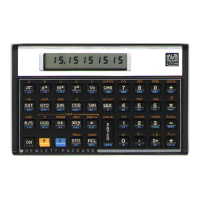36 Section 3: The Memory Stack, LAST X, and Data Storage
Reverses the function that
produced the wrong answer.
Calculator Functions and the Stack
When you want to key in two numbers, one after the other, you press
v between entries of the numbers. However, when you want to key
in a number immediately following any function (including manipulations
like )), you do not need to use v. Why? Executing most HP-15C
functions has this additional effect:
The automatic memory stack is lift-enabled that is, the stack will lift
automatically when the next number is keyed or recalled into the
display.
Digit entry is terminated, so the next number starts a new entry.
There are four functions v, `, z, and w that disable stack
lift.
*
They do not provide for the lifting of the stack when the next number is
keyed in or recalled. Following the execution of one of these functions, a new
number will simple write over the currently displayed number instead of causing
the stack to lift. (Although the stack lifts when v is pressed, it will not lift
when the next number is keyed in or recalled. The operation of v
illustrated on page 34 shows how v thus disables the stack.) In most
about them.
*
− will also disable the stack lift if digit entry is terminated, making − clear the entire display like
`. Otherwise, it is neutral. For a further discussion of the stack, refer to appendix B.

